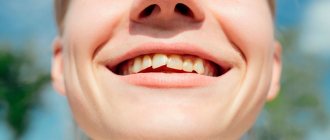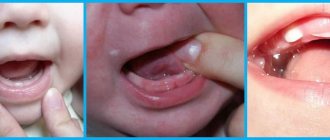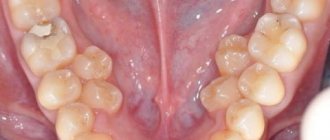Symptoms
Pericoronitis is accompanied by a number of symptoms.
- Objective symptoms that can be seen by the patient himself or the dentist during an examination of the oral cavity.
The presence of a mucosal hood on the surface of the erupting tooth and a pathological gingival pocket are determined [6,9,10]. Externally, at the site of the erupting tooth, the gum tissue is hyperemic (red), voluminous due to swelling. The causative tooth may be mobile.
During the examination, the dentist evaluates the regional lymph nodes (cervical, submandibular, preauricular), their size and the presence of pain. An increase in the latter indicates a prolonged course of pericoronitis. With mild severity, the body temperature rises to 37°C, and in the presence of purulent complications - to 38-39°C [2,5,13]. The face with pericoronitis is asymmetrical, due to swelling and enlargement of soft tissues on the affected side.
- Subjective symptoms caused by the patient’s sensations.
Pain in the gums occurs at rest and intensifies when brushing teeth, chewing food, talking and opening the mouth. Pain sensations can spread along the branches of the trigeminal nerve to the ear and eye[7]. There is an unpleasant, putrid odor from the mouth. General health worsens, weakness occurs, sleep is disturbed, appetite and performance decrease. In response to pain, the masticatory muscle spasms, making it difficult to open the mouth, chew and swallow food[11].
Tooth dystopia - symptoms and treatment
One of the mechanisms for the development of dystopia is associated with the abnormal arrangement of tooth germs, which is formed during intrauterine development. The second reason is pathological teething. It is caused by disorders of embryonic development associated with the formation of a tooth germ. They can manifest themselves in the form of macro- and polyodontia, a pronounced disproportion of temporary and permanent teeth.
Another cause of dystopia is genetic characteristics. Sometimes the size of the teeth acquired from one parent does not match the size of the jaws acquired from the other parent. This discrepancy can lead to crowding of the teeth or the appearance of spaces between them, which can further contribute to the development of dystopic teeth.
Exogenous factors of dystopia, as a rule, are traumatic in nature. These include scarring on the gums, mechanical damage to the teeth and bad habits such as thumb sucking or biting a pen or pencil. For example, with prolonged thumb sucking, the incisors of the upper jaw change the direction of growth, thereby forming an open bite.
Also, the development of dystopia is provoked by partial adentia, premature removal of baby teeth, and violation of the timing and sequence of eruption.
Late teething is promoted by:
- damage to dental follicles due to trauma or infection in the area of primary teeth;
- development of a benign tumor and odontogenic cyst;
- anomalies in the size and shape of adjacent teeth;
- excessive retention of baby teeth in the socket;
- impaired jaw growth after injuries, endocrine disorders, rickets, vitamin deficiency and hypovitaminosis [5].
The effect of the endocrine glands on metabolic processes and the formation of the dental system begins in intrauterine development. For example, children born to mothers with toxic goiter (autoimmune disease of the thyroid gland) experience intrauterine eruption of primary teeth, a delay in the appearance of permanent teeth, early mineralization of the crowns and formation of the roots of permanent teeth.
Against the background of acquired hypothyroidism, the rate of eruption of milk and permanent teeth slows down. Teeth of atypical shape appear, some elements rotate around their axis or begin to grow outside the dental arch.
With rickets, the growing body lacks vitamin D. As a result, the exchange of phosphorus and calcium, which play an important role in the formation of jaws and teeth, is disrupted. This causes the jaw bones to become underdeveloped, narrowed, or flattened, preventing teeth from growing and functioning properly. In these cases, they pile up on top of each other, that is, they crowd together.
An excess of vitamin A causes abnormal growth of the jaws, tongue and dentin density. With a lack of vitamins A and B, atrophy of the salivary glands may develop, which leads to changes in the periodontium. With a lack of phosphorus against the background of normal levels of calcium and vitamin D, jaw growth and teething slow down, which subsequently leads to dystopia and malocclusion.
Types of pericoronitis
Pericoronitis is divided into acute and chronic according to the nature of its course. The first can be catarrhal (mucous discharge predominates), ulcerative (with the formation of erosions and ulcers) and purulent (pus is released) [12,15].
Acute pericoronitis is characterized by:
- rapid start;
- pronounced pain syndrome;
- the presence of discharge from under the gum hood (first serous, then purulent);
Chronic pericoronitis is characterized by:
- sluggish course of the inflammatory process;
- mild symptoms of pain and dysfunction of chewing, swallowing, speech;
- alternating periodic exacerbations and subsidence of symptoms;
- destruction of the cortical plate around the causative tooth and its mobility;
- spread of inflammation to the soft tissues of the pharynx, cheeks, sometimes with the formation of fistulas (canals).
Catarrhal
Catarrhal pericoronoritis is the mildest, initial form of inflammation of the mucous membrane around the erupting tooth [5,9]. This type of disease is characterized by redness of the mucous membrane and swelling of the overhanging edge of the gum. There is no discharge from under the hood between the gum and tooth.
The patient complains of itching of the gums, slight pain in the area of eruption, which may intensify while eating, when touching the affected area of the gums, or closing the jaws. With timely initiation of treatment, acute pericoronitis goes away without a trace [10].
Ulcerative
A characteristic sign of ulcerative pericoronitis is the presence of ulcers on the edges of the hood hanging over the causative tooth. At the site of inflammation, there is an abundant deposition of soft plaque, after removal of which bleeding and gum pain are observed [1,18]. Regional lymph nodes are enlarged, body temperature rises to 37.5°C.
Purulent isolated subacute
The course of purulent pericoronitis is longer than in the acute process, and is therefore classified as subacute. The disease is accompanied by severe pain, which intensifies when chewing, swallowing and speaking, and radiates to the temple and ear. Opening the mouth is difficult and painful [6].
When pressing on the tooth, purulent discharge is released from under the hood of the mucous membrane. A putrid odor appears from the mouth, the patient constantly feels the taste of pus in the mouth[3]. There is enlargement and tenderness of the submandibular lymph nodes. The long course of purulent pericoronitis is accompanied by ulceration of the gums with subsequent scar formation [6,8].
Retromolar periostitis
Inflammation of the periosteum in the area of the last molar of the jaw (wisdom tooth) develops due to purulent pericoronitis and is called retromolar periostitis. The mechanism of development of this disease is associated with the spread of pus under the crown and periosteum of the alveolar process of the jaw, where the wisdom tooth is located [20].
The disease can be suspected if:
- sleep disturbances, including insomnia;
- decreased appetite;
- facial imbalances due to swelling of the painful side;
- decreased functions of the dental system (opening the mouth, chewing, swallowing, speaking);
- temperature rises to 38.5°C.
Treatment of retromolar periostitis is carried out by treatment and excision of non-viable gum tissue, drainage of the purulent focus and complex detoxification therapy (drinking plenty of fluids). In the absence of therapy, purulent melting of the jaw bone tissue, fistula tract and abscess of the soft tissues of the face may develop [17].
Spicy
The acute course of pericoronitis is characterized by a rapid onset, rapid inflammation of the gums near the causative tooth, and severe pain symptoms [15,20]. It develops as a result of complicated tooth eruption, which is caused by its incorrect location in the dental arch or individual structural features of the tissues covering the tooth before its eruption (periosteum, gingival mucosa) [5.9].
The condition for the development of acute pericoronitis is a low oral hygiene index. A direct relationship has been established between the presence of a large amount of dental plaque and the likelihood of developing inflammation of the injured gum mucosa at the time of teething [19].
THE WEBSITE IS UNDER CONSTRUCTION!!!
Teething in children: timing, symptoms, possible complications
At the age of five to six months, a difficult period begins in the life of the child and his parents. Teething syndrome in children is a special physiological condition, which is accompanied by characteristic symptoms : fever , swelling and pain in the gum tissue, loose stools, loss of appetite and other unpleasant symptoms . At this point the child becomes capricious, loses activity, and often cries.
However, some parents, during the period of eruption of the first milk teeth in infants , ignore the baby’s , preferring to simply use painkillers instead of seeking medical advice. Such a mistake can be costly, because by attributing all disorders to a natural physiological process, parents risk ignoring the signal that the child is sick. The process of teething in a baby is a serious reason to go to see a doctor, because it is not for nothing that this syndrome was separately included in the international classification system of diseases ICD 10 , under the index K00.7. Only an experienced and qualified specialist will be able to distinguish the symptoms of the eruption of the first teeth in a six-month-old baby from the manifestations of more serious pathologies that may threaten the child’s health. Professional and timely diagnosis in a medical institution is the only guarantee that treatment of a dangerous disease will begin at an early stage and be successful. And even if there is only a natural physiological stage of the child’s development, the doctor can determine how the process is proceeding and whether any deviations from the norm are observed. And if necessary, an experienced specialist will prescribe effective medications and ointments to relieve teething pain or relieve other symptoms that bother the baby .
Features of the teething process, timing and order of appearance
The statistical norm for the appearance of the first baby teeth in a baby is six months. However, modern medical practice confirms the existence of a tendency to speed up this process. Signs of teething can be observed in children aged five months and, in rare cases, four months. By the first year of life, up to eight incisors can already be observed in a child’s mouth, and by about three years the rest appear. It is worth noting that the dynamics of manifestation and growth depend on many indicators: the sex of the child, heredity, diet, indicator of physical activity, degree of development of organs and systems.
There is no universal data on this issue, but there is a conditional table that reflects the approximate timing and order of teething in children :
- The lower incisors begin to appear very first, this process lasts until nine months of age;
- The upper incisors grow between seven and ten months;
- Lateral incisors from 9 to 12 months, parallel above and below;
- The eruption of the front molars in children will begin from one year to nineteen months, the second ones appear much later - almost at the age of two years;
- The upper canines range from 16-20 months, and the lower ones - up to 22 months.
Symptoms of teething in children and signs of disruption of this process
The first symptom that parents most often pay attention to is fever. Deviations from the norm are usually not too significant - within 37.5 - 38 degrees. It is worth monitoring not only the magnitude, but also the duration. A natural increase in temperature is usually easily relieved with antipyretic drugs. A persistent increase in temperature above 38 indicates that teething syndrome occurs with complications. At this age, the primary immune system is just forming in the child’s body, and inflammatory or even infectious processes can develop in the oral cavity and intestines.
The second important sign that can help the doctor during the eruption of baby teeth is the nature of the mucous discharge. Swelling of the nasal cavity and gums is a natural process during the growth of fangs and incisors of the upper jaw; the mucus is watery in nature. Thick and colored discharge is a sure sign of an ENT disease.
One of the symptoms of teething in babies is also loose stools. In this case, the consistency becomes only slightly thinner than usual. Do not confuse the signs accompanying tooth growth with diarrhea. If a child has a serious intestinal disorder for several days, and eating is accompanied by vomiting, then you should urgently go to the hospital, where an infection will most likely be diagnosed.
But most often, parents turn to doctors with complaints about gum replenishment. Teething is a process in which soft tissue is torn, causing pain . A qualified professional will prescribe topical anesthetics to relieve discomfort and recommend massage techniques to speed up the process. Under no circumstances should you select medications on your own.
Dental hypersthesia
Dental hyperesthesia is an increase in the reaction of enamel to chemical and temperature provoking factors. Also, painful sensations can occur with acidic foods - fruits and berries. Discomfort is possible when chewing food and hygienic cleaning with a regular brush.
Dental hyperesthesia according to ICD-10, this condition is assigned code K03.8. It is important to understand that in most cases, increased sensitivity of the hard tissues of dental units is not an isolated pathological process. It occurs as a response to concomitant diseases.
In the branches of West Dental family dentistry in Vsevolozhsk and Yanino-1, our specialists, dental therapists, will help solve this problem. They will select the necessary measures for the prevention and treatment of this disease. In this article we will talk in detail about what dental hyperesthesia is and its varieties. You will learn how to prevent its occurrence and fight it.
Causes
Hypersensitivity of hard tissue structures of teeth can develop for certain reasons:
- Mechanical trauma to enamel - when cleaning at home, using an excessively abrasive paste or a brush with hard bristles, applying a lot of force to the enamel.
- Multiple acid exposure - juices, carbonated drinks, fruits and berries.
- The presence of pathological conditions in the oral cavity that violate the integrity of the structure of enamel prisms: carious process, wedge-shaped defect, erosion.
- Gum recession is the exposure of the cervical area of the teeth due to bite pathology, inflammation of the gum tissue, and vitamin deficiency.
- Exposure to radiation - increased occupational hazard, radiation exposure.
Hyperesthesia of tooth enamel may be a temporary phenomenon. Thus, it appears in the first 2 days after professional cleaning due to the removal of hard deposits or office lightening of the enamel.
There are factors that provoke symptoms - heavy smoking; dry mucous membranes due to endocrine pathologies; gagging; gastrointestinal diseases.
Treatment
The main therapy for hypersensitivity focuses on eliminating provoking causes and slowing down the flow of dentinal fluid in the tubules. This therapeutic regimen is performed:
- Clogging of micropores and cracks in the hard tissue structures of dental units with desensitizers - specialized means that reduce tissue reactivity.
- Narrowing micropores with mineralizing agents. Specialized gels containing fluorine and calcium. Restoring the mineral balance in the hard tissue structures of teeth helps to achieve high results. This technique is a fundamental part of preventive measures to combat caries and other pathological processes.
- Narrowing or complete blockage of tubules in dentin under a directed laser beam.
It is important to know that sensitivity formed due to loss of gingival and bone tissue, gum recession, will require major therapeutic and surgical interventions. It is necessary to perform comprehensive treatment of periodontal disease to restore a full life and diet.
If the symptoms are caused by pathological closing of the jaws, then orthodontic treatment is necessary. So, when the carious process develops, the doctor will remove the affected structures and further restore it with specialized material. If the process is complicated by pulpitis, endodontic treatment will be necessary - extirpation of the pulp bundle, mechanical and medicinal cleaning of the root canals with their further filling. Finally, restoration of the anatomy of the cusps and fissures of the chewing surface with filling material.
West Dental specialists have all the necessary knowledge, and the clinics have high-tech equipment to select and provide suitable therapy, taking into account all the symptoms of the process. Today, gels, pastes, and varnishes with fluorine and calcium are widely used. It is possible to use electrophoresis and vitamin therapy.
Doctors at West Dental branches will provide highly qualified assistance in treatment of any complexity. You can make an appointment for a consultation by phone or on the website.
Manifestations
Dental hyperesthesia (according to ICD-10 K03.8) is manifested by a brief pain reaction when interacting with irritants. Unpleasant sensations usually do not exceed a few seconds in duration and appear with some regularity under the influence of a disturbing factor.
The severity of the pain varies - from inconvenience to difficulties with cleaning and standard meals. Such symptoms reduce the quality of life and can force you to change your usual diet and lifestyle.
Some of the most severe symptoms occur with improperly formed enamel; carious process at the neck of the coronal part; severe abrasion of chewing surfaces.
High enamel reactivity can occur in one unit or all of them in the oral cavity. With a single lesion, one unit reacts, and with a developing erosive pathological process, the entire row will be affected.








